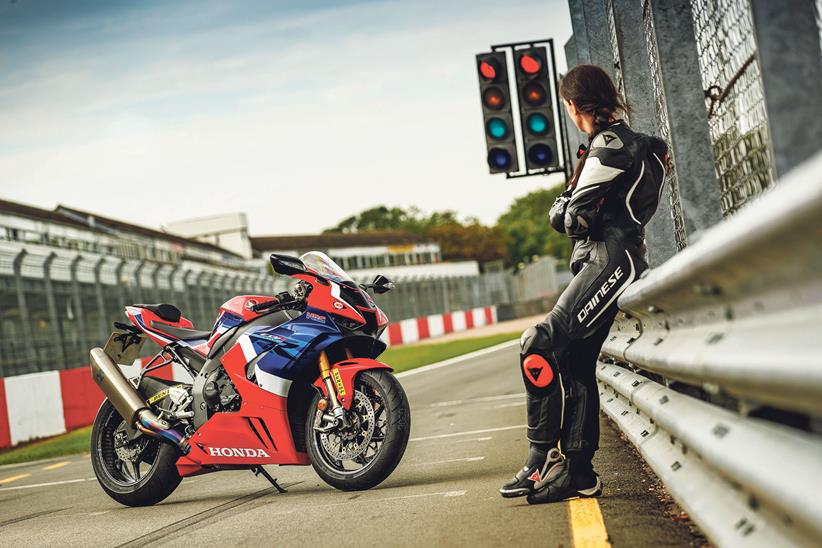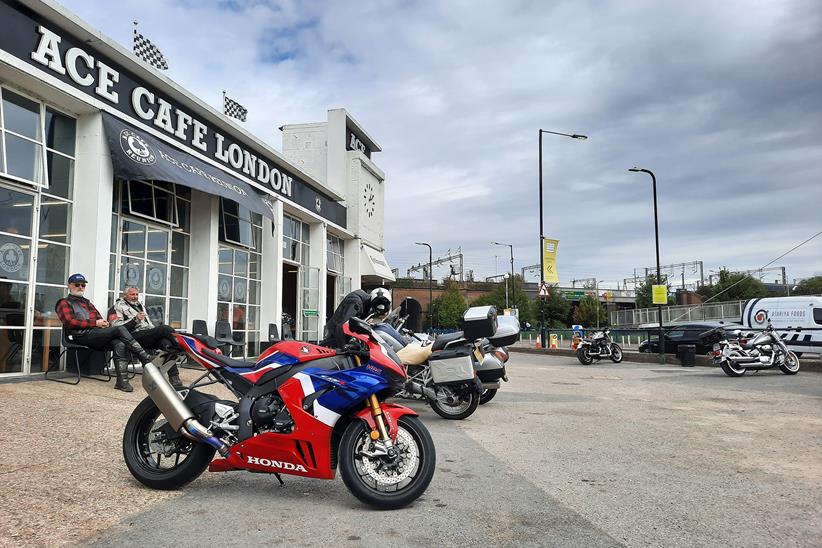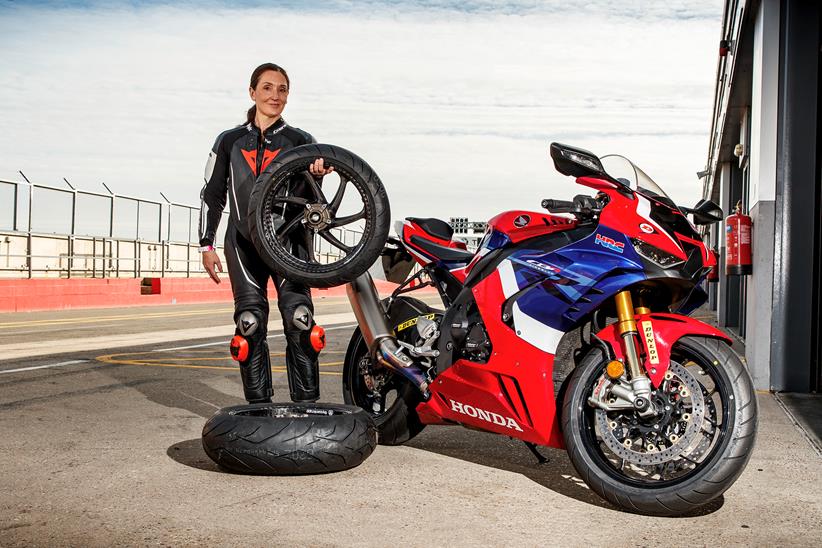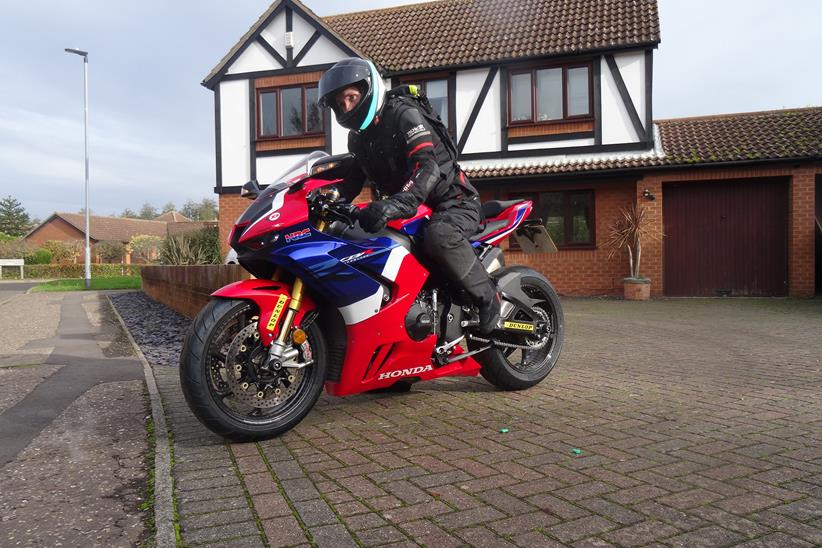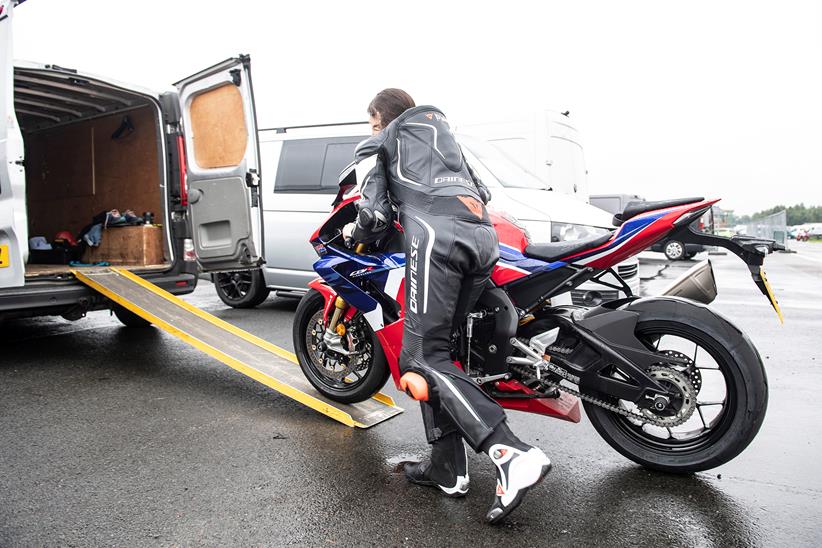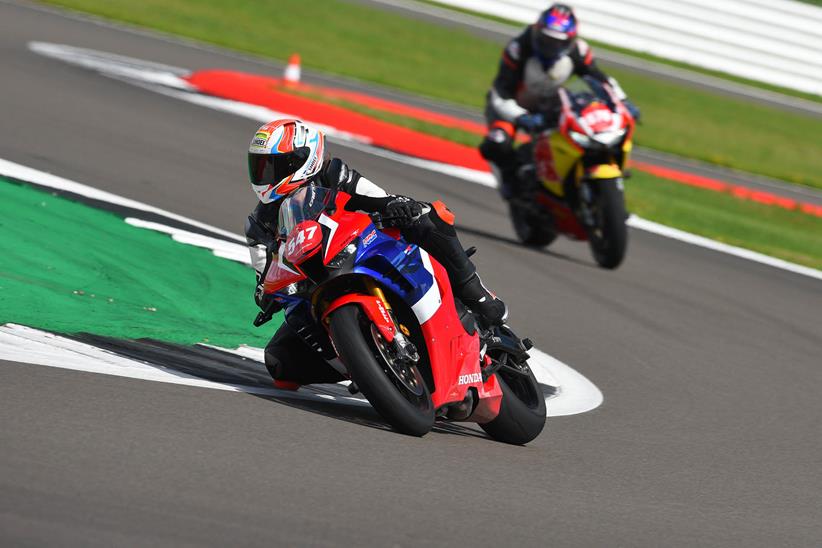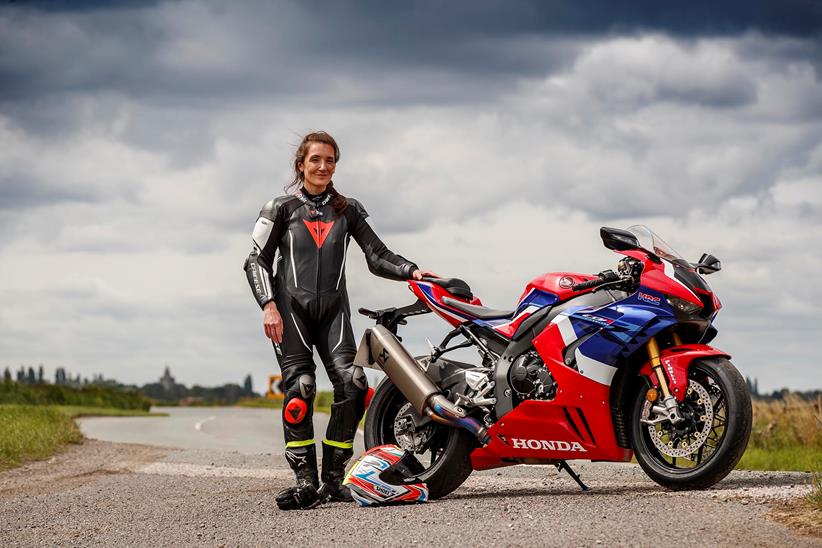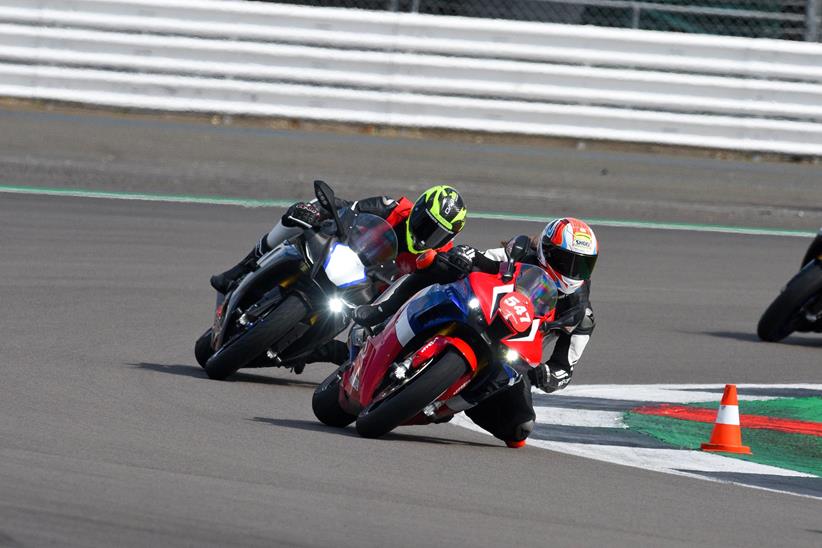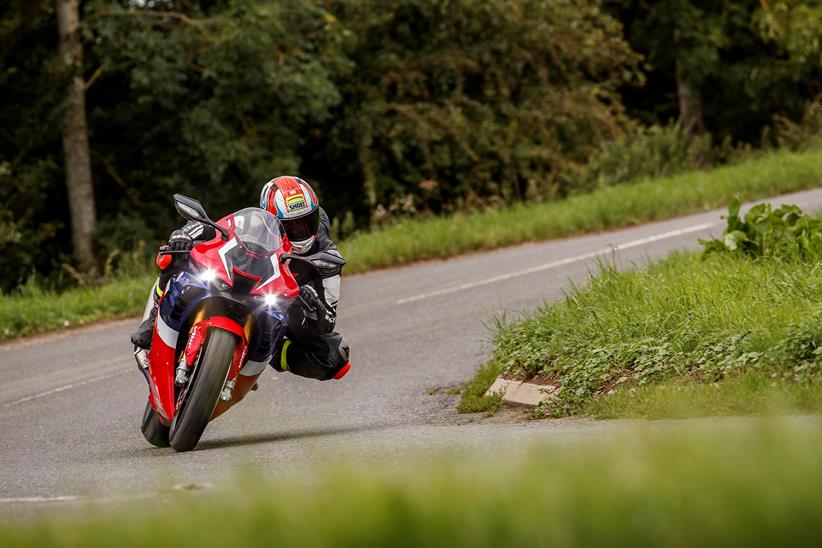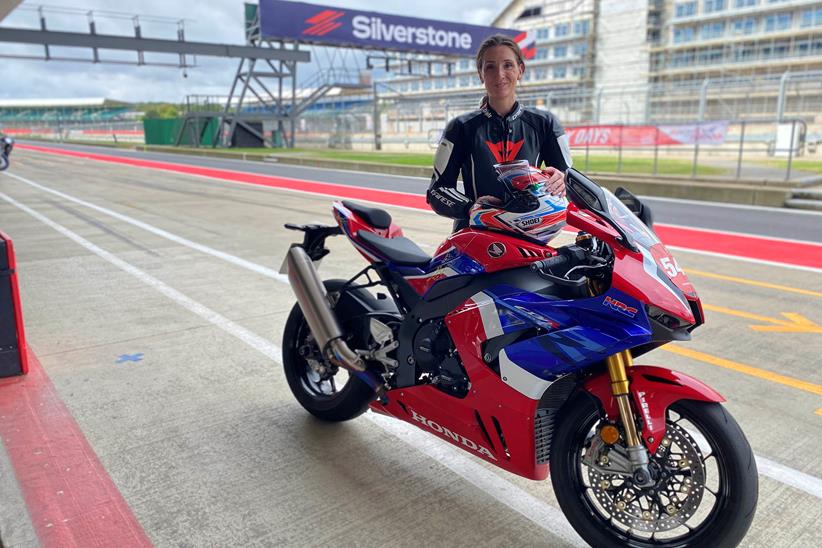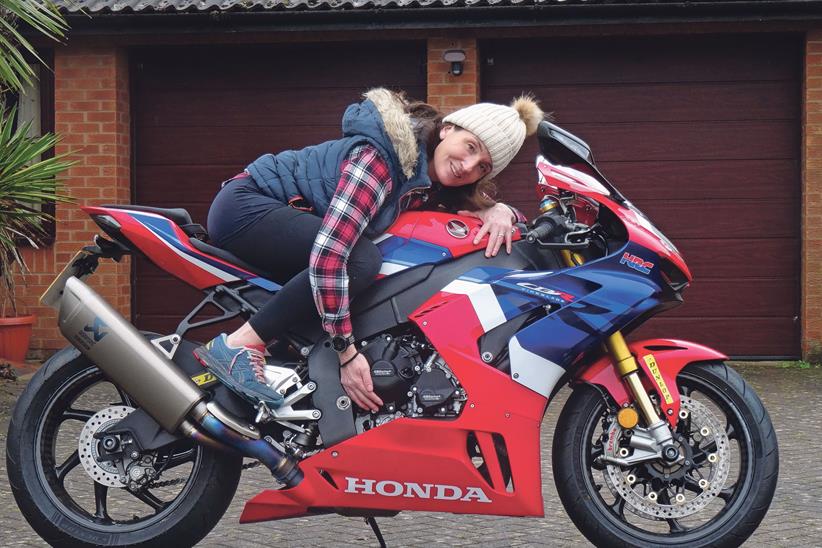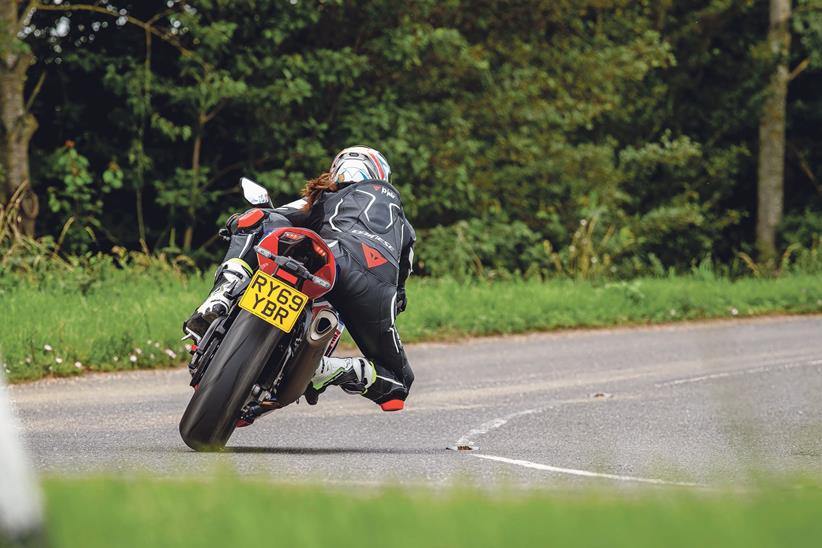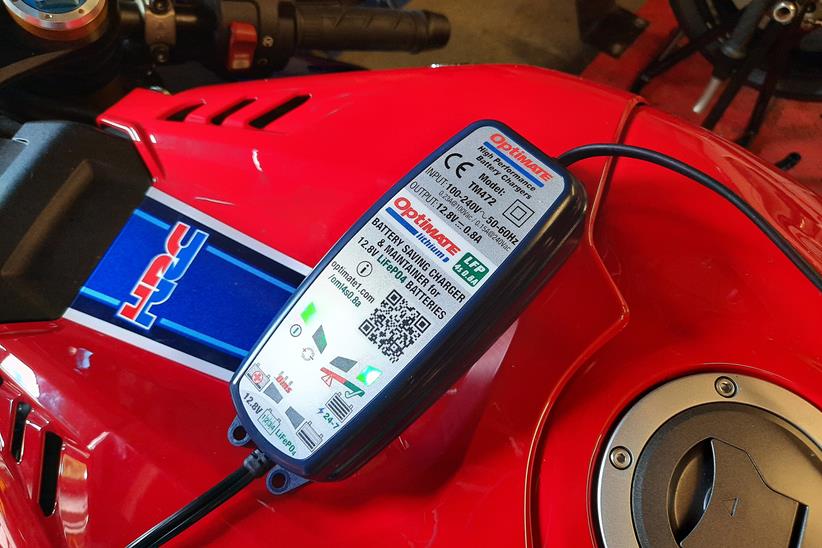MCN Fleet: The Honda Fireblade SP finds a permanent home
Maybe it’s the ‘Lockdown Effect’, or perhaps it’s what’s known as a mid-life crisis (they’re not just for men, you know?) But whatever the reason, the result is I’m now the proud co-owner of a 2020 Honda CBR1000RR-R Fireblade SP.
My time with MCN’s long-term test Fireblade has basically been a very-extended demo ride. In between last year’s lockdowns, I’d racked up over 2500 miles doing fun local loops, longer motorway grinds and even managed to squeeze in four trackdays. But I still felt I’d not even scratched the surface of what the Fireblade SP could do – and, most importantly, I’d not got bored. Every ride, even if it was sixth-gear highway cruising, to me was absolutely thrilling. I’d never ridden a Honda – or indeed any motorcycle – quite like it. The CBR1000RR-R got its claws into me, good and proper….
More long-term tests
- Video round-up of the Royal Enfield Interceptor
- Saying goodbye to the BMW F900XR TE
- Final thoughts on the 2020 KTM 1290 Super Duke GT
So, when the chance to buy a used RR-R came my way, I found myself face-to-face with serious temptation. I’d just sold my Kawasaki KR-1S so had a bit of spare cash and, as my partner was also up for going halves (spoiler alert: he didn’t take much convincing), we decided to take the plunge into ownership. I call it an early 40th birthday present….
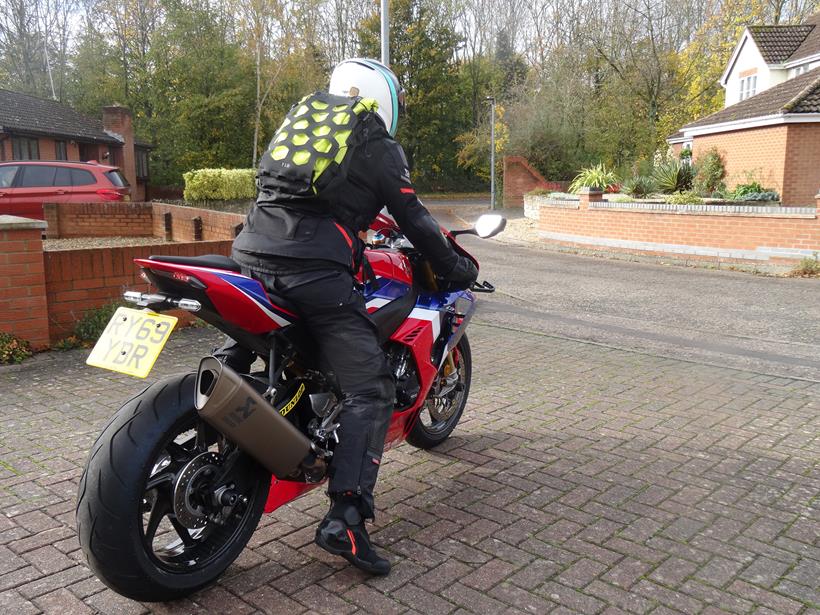
Now, I already knew what I’d be getting into from a riders’ point of view, but what a long-term test can never quite put into perspective is all the nitty gritty of ownership. How much a bike like the Blade costs to run, even if it’s just sat in the garage not being ridden (as mine has been since December.)
First, insurance. As a rider with 17 years’ experience, six years’ NCD and (ahem) three penalty points, the Fireblade costs £398 per year to insure on a comprehensive policy with BeMoto. That’s also with a prerequisite Datatool Stealth S5 tracking system fitted to it (which came with the bike), costing £9.95 per month (or £109 per year) for the subscription. Then there’s the vehicle tax, £93 for 12 months.
Next up is servicing. The CBR1000RR-R’s service intervals are an impressive 8000 miles… or every 12 months. As my bike has just 2000 miles on its clocks but has just celebrated its first birthday, that means a service is needed in order to keep the balance of the two-year warranty live. That’s £190. This all means that the Blade costs roughly £85 every month to keep taxed, insured, serviced and protected, regardless of whether it’s being ridden or not.
Then there’s the parts; idly flicking through the owners’ manual, co-owner Bruce noted that Honda recommend that caliper bolts are replaced every time they’re removed. Annoying, you might think, but as an important safety component you shouldn’t question it… However when you discover that each one costs £31 (£124 for a set of four) it might have you wondering how long you could get away with reusing them…

Then there’s the depreciation factor. Buying used means we’ve avoided taking the first hit of devaluation, but what next? Will this evolution of Fireblade be written off in the minds of the bike buying public as a leap too far for Honda and we’ll have to sit and watch as values plummet? Or, will it weather the depreciation storm by winning WSB and BSB to be held aloft as the pinnacle of modern litre sportsbikes – one last, mad display of engineering genius before the world becomes sanitised and 200bhp road bikes will only feature in the tales we tell our grandchildren?
I don’t know the answers – and in all honesty, at the moment I’m not too fussed – because right here, right now, I’m just going to relish being the owner of a bike as bonkers, brilliant and beautiful as the Blade. Trackday, anyone?
Update eight: Factory support for the Honda CBR1000RR-R Fireblade SP
Published: 05.03.21
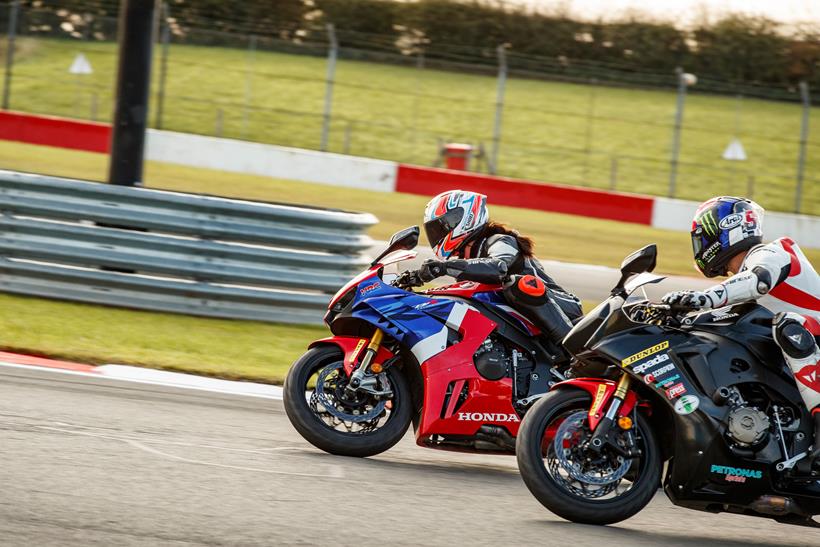
The Honda CBR1000RR-R’s third R stands for Racing: it’s what the bike was designed to do. Honda’s all-new, MotoGP-inspired inline-four production racer has been bred to win World Superbike titles. So too has their factory rider, Leon Haslam. A superbike champion of outstanding pedigree, himself bred for racing, the 2018 BSB champ signed for HRC’s WSB squad at the end of 2019 alongside Alvaro Bautista. His mission: to help take the Japanese manufacturer back to their WSB glory days.
Back in 2007 the Fireblade notched up 22 race wins and took James Toseland to the title which, amazingly, was the last time Honda won the WSB championship. Given the fact that they’ve now also gone four seasons without a race win, you can see why the Big H have gone to such lengths with the new CBR1000RR-R Fireblade. But 2020 wasn’t the best year to make a big WSB racing comeback….
“It was a strange season for everyone,” said Leon Haslam when I caught up with him at an MSV-T trackday at Donington Park back at the end of October, where the HRC factory rider was sharing his considerable riding know-how with a starry-eyed bunch of keen trackday riders, myself included. “It was a short season with a new team and a new bike, so it was difficult to understand which direction to go, especially with so few tests, too,” he admitted.
“But hopefully we can reach the top step of the podium and challenge for the title in 2021.” With the new Blade being so unashamedly track focused, and also with tales from the world press launch hinting that Haslam and Bautista had been flying around Qatar on road-trim Blades in just two minutes flat, [the outright WSBK lap record is just 1:56.1] I wanted to know just how close my long-term test Fireblade actually is to Haslam’s full-factory racer.
“Honestly, the standard road bike is very fast. I mean VERY. Riding it at the world press launch in Qatar, Alvaro and I were only a few seconds off race pace, so the level of performance is fantastic. The chassis is very different from the last bike – it is much more stable and better suited to big power and grippy tyres – plus the road bike electronics are very advanced which means you don’t have to push too hard to get the best out of it. It’s weird to think that a bike people ride on the road and go to the shops on is so similar to the bike I push to the absolute limit in World Superbike races.”
So, when it comes to an enthusiastic-but-essentially-lacking-in-talent trackday rider getting the best from the Blade, what’s the best method of attack?

“You’ve got to get boss of it,” said Leon. “I always like to find out exactly where the level of grip is at the start of a session by unweighting the seat and deliberately spinning the rear whilst upright, that way you dial in your throttle control and get a feeling for the track.
“When you’re sat on the Blade, you need to be as far forward as possible to not only reduce strain on your arms under braking and prevent wheelies from hard acceleration, but also it allows the rear end to do its own thing meaning if it does step out then it’s less likely to unseat you.
“The next secret is all about turning hard. The Fireblade steers really well, but you’ve got to maximise the cornering line by turning it hard and getting to full lean really quickly, and the best way to do this is by using an off-throttle cornering technique. By braking slightly earlier and not as hard then changing down into a revvy gear and coasting to the apex using engine braking, it allows you to use a tighter line on corner entry so you can stand the bike up and fire it out hard on the throttle at the exit so you can maximise top speed on the straights. The Blade’s revvy engine characteristic is ideal for this, but we have found that it can be quite hard on tyres during the course of a race.”
With lockdown still in full effect, it looks like I’ll have a few weeks longer to wait before I can put Leon’s wisdom into practice again, as MSV-T’s trackdays are due to restart on Tuesday March 30 at Donington Park (www.bike.msvtrackdays.com). And as for the factory man himself, both he and Bautista will be lining up for action in Estoril on May 7-9 – I can’t wait to see what 2021 has in store for the Blade.
Update seven: The Honda CBR1000RR-R Fireblade SP gets protected
Published: 03.02.21

Crash protection has always been a bit of a dilemma for me; on one hand I want to protect my bike against damage caused by those unscheduled horizontal moments. Yet, on the other, I really don’t want ruin its day-to-day good looks by fitting loads of pricey plasticky covers, bungs and guards for that once-in-15-years chance of a spill.
This vanity-over-practicality philosophy has been made worse by living with the beautiful Blade, simply because of its high-quality components and stand-out looks.
So, when MCN’s workshop guru Bruce Dunn needed a bike to star in one of his How To guides, I was more than a little reluctant when he told me he’d be bolting on engine covers and a brake lever guard.
More long-term tests
- Video round-up of the Royal Enfield Interceptor
- Suzuki V-Strom 1050XT gets fresh tyres
- Saying goodbye to the BMW F900XR TE
Yet the results – achieved using an engine protection kit from GBRacing, and Evotech Performance’s brake lever guard – have made me change my beliefs on bolt-on accessories. The overall effect created by the accessories from this pair of top-rated British firms is that of factory-spec understatement – like they’re standard parts or official optional extras. Not in the least bit in-your-face, tawdry or weak looking.
The engine cover set (£199.96) from GBRacing has, like all their kits, been designed as model specific parts to a very high spec. Bruce was impressed with how easily they bolted on as well as their overall design and quality.
“These are FIM-approved covers so they’ve had to meet a certain high spec in order to be allowed on to the world championship grid. I love how well made they are, such as the metal-lined bolt holes, selection of high-quality and model specific fastenings,” he said.
He makes a good point about the fit and the attention to detail – you wouldn’t want a poorly designed engine cover to cause you more harm than good by either damaging your bike in a crash or even causing a crash by allowing oil to leak from metal casings beneath.
Sure, you could save yourself £40 by purchasing a similar looking Chinese kit from Amazon, but if you’re going to bother with crash protection at all, you may as well make sure it’s been proven to perform.
Now that brake lever guards are compulsory for all bikes on trackdays this year, I’m chuffed to have my Evotech guard (£99.97) installed on my right-hand bar. Evotech parts are beautifully made and look unquestionably strong. I especially like how the black coated finish over the aluminium matches that of the Blade’s frame perfectly, making the lever guard look like an OEM part.
Again, sure there are lever guards available for a fraction of the price (£14) on that all-powerful online marketplace, but there’ll be a universal fit and of questionable quality – and could potentially cause more problems than they’ll solve.
Update six: The light fantastic for the CBR1000RR-R Fireblade SP gets carbon clad
Published: 08.12.20

What’s black, round, weighs 5.7kg and has the power to considerably increase the kudos of Honda’s, already stunning, CBR1000RR-R Fireblade SP? Give up? Let me tell you, it’s a pair of thyssenkrupp Carbon Components wheels. But these aren’t just any old carbon wheels…
Costing €3411 (£3096), price-wise they’re on par with rival brands, however even the untrained eye can see that the tkCC rims are a different breed of carbon loveliness; fat wefts of carbon fibre create a millimetre-perfect chequerboard effect that seems to illuminate from within as the light catches the intricate weave. They are simply spellbinding to look at, but they’re strong too.
More long-term tests
- Bad luck on the Royal Enfield Interceptor
- Triumph Tiger 900 Rally Pro – the story so far
- KTM 1290 Super Duke GT coastal tour
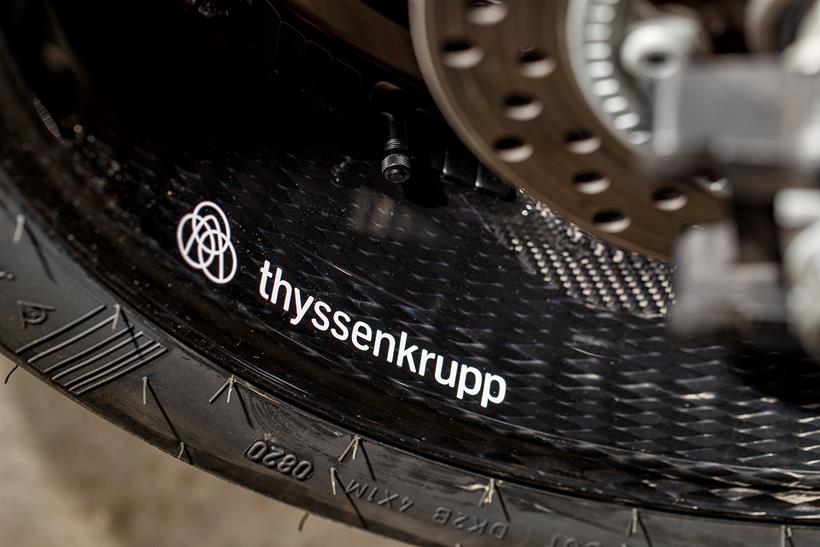
Whereas traditional carbon-fibre wheels are made using a process called prepreg lay-up, where pieces of resin-infused carbon fibre are applied into a mould and then cured in an autoclave, these tkCC rims are spun from a single thread of carbon fibre by a 9m-wide loom in a process known as braiding. German company thyssenkrupp are one of the pioneers of the technology, having supplied the OE wheels for BMW’s carbon-laden HP4 Race as well as the Porsche 911 Turbo S.
The braiding process allows the wheels to be both much stronger and lighter than prepreg wheels. As a result they’ve got German National Type Approval for road use, meaning they’ve been developed and tested to withstand high ‘abuse loads’ – stresses placed on a wheel outside of normal riding, such as hitting kerbs, potholes or hard debris. All very reassuring to know, but I was keen to feel what difference they made to the, already sweet-steering, CBR1000RR-R Fireblade SP.
The 100mph+ direction change at Donington Park’s Craner Curves provide the perfect proving ground. Overcoming the bike’s gyroscopic desire to carry on going straight in order to initial a turn becomes more difficult the faster you go. This gyroscopic effect is generated by the rotating mass of the wheels, therefore anything to reduce this mass will also reduce the gyroscopic effect and make the bike feel easier to turn. And when you’re hurtling downhill at triple-figure speeds trying to peel over from the right-hand side of Donington’s tarmac towards Craner’s left-hand apex, any reduction in effort is much appreciated.
After doing a few laps on the ‘Blade with its standard wheels, I enter the pits to put on the new braided carbons. While I wait, I take the chance to weigh both front wheels and discover that, minus discs and tyre but including bearings and valves, there’s 1.7kg difference between standard and carbon – the SP’s cast (not forged, like on the old RR SP) aluminium front wheel weighs 4.1kg compared to 2.4kg of the carbon.
With the tkCC wheels slotting in perfectly without any need for modification, it was time to head out on track. Instantly I notice a definite difference to be felt in the steering, but it’s not as dramatic as I was expecting. The bike feels eager and alive – without instability – and it’s definitely a little easier to fling it from right to left down Craner, but after a few laps I’ve forgotten all about them and am just revelling in the Blade’s on-track superpowers.
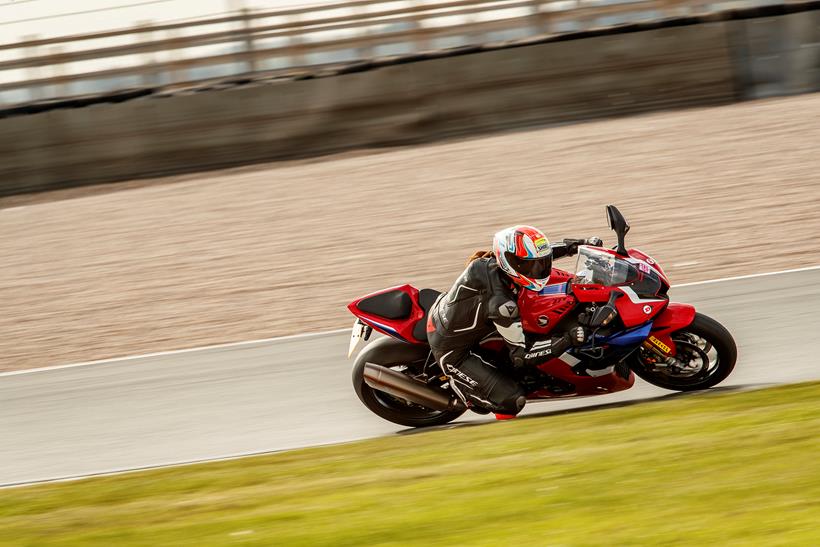
It wasn’t until I left the circuit that the carbon wheels made their presence felt again. Riding round the small roundabout outside Donington’s paddock, such is the dramatic rate at which the Blade turns at low speed that I think I’ve lost the front! The same thing happens when turning out of the next junction, and not only that but the Blade feels much more keen and nimble when darting through traffic, too. A bizarre case of something being created for the track that’s actually better on the road!
Not only that, but thanks to the reassurance of the German National Type Approval, my heart’s not in my mouth every time I hit an unsighted pothole – I know the tkCC wheels are certified as tough enough to take it.
Update five: No one-trick pony – Honda’s CBR1000RR-R Fireblade SP does the donkey work
Published: 11.11.20

Hands up, I admit it; all that marketing spiel regarding the new CBR1000RR-R SP being bred for the track not for the road has been swallowed wholesale by me. In the four months since collecting it, each and every ride has been purely for high-speed fun – be it on the road or on one of the four trackdays I’d managed to squeeze into our shortened summer.
So, because of all the ‘using it as it was intended’ I’d been doing, it’s with a bit of embarrassment that I say that I’ve not done much everyday to-ing and fro-ing on the new Blade. Comfort, smoothness and fuel economy isn’t much of a concern when you’re flat on the tank down Craner Curves…
Despite what Honda want us to believe, the new Fireblade is a road bike so I thought it was high time that I left the kneesliders at home and actually used it as a form of transport.
With a 10am appointment at London’s Ace Café, the Blade got its first taste of long-ish distance motorway cruising as I joined the A1(M) and quickshifted my way up into top gear. Despite not being at a wide throttle opening, the SP’s ‘shifter still works as smoothly as it does when used in anger, it’s just that at this speed the needle drops below 5000rpm and disappears from the face of the analogue-style digital rev counter, one of the many choices of display configurations on the Blade’s TFT dash.
Despite its off-the-clock low rpm, the RR-R will still allow you to roll on and off the throttle in sixth gear to keep pace with or pass other motorway traffic. The engine’s incredibly smooth – beautifully so – and there’s no protestation from the motor for asking it to accelerate from low rpm in top gear; granted, there’s no rip-your-face-off-acceleration but it doesn’t bog down, as you would expect for an engine as peaky as this one, far from it.
Vibrations through the bars and pegs simply don’t exist, and despite a lot of other riders grumbling about the Blade’s supposed extreme riding position, I can honestly say that I find it perfectly comfortable with no aching knees or burning pain in my shoulders. I’ve certainly felt worse on a sportsbike – Yamaha’s R1M springs to mind, or for that matter Suzuki’s Hayabusa – a supposed sports-touring king.
This smooth, unhurried, low-rpm motorway cruising also sees the Blade’s mpg increase from 31mpg on track (110 miles to a tank) and to 41mpg on a fun road ride (145 miles to a tank), to a slightly more impressive 47mpg on the motorway (166-mile range). And, as we float the 70 miles back from London, the Ohlins S-EC suspension set in Road mode cocooning me from the lumps bumps, I’m kicking myself that spent so much time chasing the Blade’s performance on track and around my local roads when I could’ve wafted off somewhere far flung and picturesque and enjoyed the ride just as much – if not more. One trick pony the Blade most certainly is not.
Update four: Fire and Brimstone: Honda’s CBR1000RR-R Fireblade SP at Silverstone
Published: 18.08.20

It’s there in black and white on Honda’s website: ‘The CBR1000RR-R SP is not built with a road-rider’s needs in mind; the race-track is where it belongs.’ The Big H have made no bones about it, this Blade is all about circuit riding, which suits me down to the ground. And what better place to take a 215bhp, be-winged, 1000cc missile than to one of the fastest, most modern MotoGP circuits on Planet Earth – Silverstone’s stunning Arena GP.
As much as it had pained me, I’d purposely waited for Silverstone to start running trackdays again post-lockdown, rather than get my first taste of the super-fast Honda at somewhere smaller, like Cadwell or Brands Indy, which wouldn’t allow the new short-stroke engine to shine as much.
More long-term tests
- First impressions of the BMW F900XR
- KTM 1290 Super Duke GT takes on rainy Cadwell Park
- Are the Yamaha Tenere 700’s extras worth the extra cash?
Silverstone’s straights – the high-speed Hangar and Wellington – are the best places in the UK to exploit a modern litre sportsbike’s potential, and in relative safety, too.
But it’s not just about the upright bits, Silverstone’s got an intoxicating mix of super-fast corners, as well as a decent sprinkling of slower ones, all of which flow together in a way that makes it feel extremely natural. It might be 3.6 miles long, but the layout is easy to learn… Mastering it, however, is a different matter.
Deputy Editor, Emma is at Silverstone GP today on the #MCNFleet @HondaUKBikes CBR1000RR-R Fireblade SP. The long straights, fast corners and unbelievably grippy surface are the perfect place for this astonishing 215bhp trackday missile. Read more here: https://t.co/Ca4K5eawUB pic.twitter.com/AIjDd4cFaa
— Motor Cycle News (@MCNnews) August 18, 2020
And the surface; let’s not forget that new-for-2019 super-grippy, billiard-table smooth surface, which for me as I went out into the damp for my first session aboard a £23,500-super-focused-sportsbike-that-doesn’t-belong-to-me, was enough to put my mind at ease.
I’ve ridden 1200 road miles with the Blade since I collected it post-lockdown and loved each and every one. But as I rolled out of the Wing pits, I realised I hardly knew the bike at all. Other than revelling in the gorgeous handling and silky power delivery (as well as countless hours spent admiring it in the garage), my road miles hadn’t given me any clue about the RR-R SP’s true character.
As I funnelled out onto the track, exhaust howl reverberating off the pit exit wall, I could open up the throttle fully for the first time without any need for hesitation; I could push the revs into their happy place without any guilt.
The engine character is a bizarre combination of mania and smoothness, and it’s very exploitable. Powering out of Aintree corner in second gear and on to the Wellington Straight, I felt confident to go to right to full throttle as I was standing the bike up, helped by the fact that I wasn’t having to wrestle against an excess of power at a point where I still felt vulnerable. I’ve never felt so instantly comfortable pinning a litre bike to the stop before. It made me feel like a proper hero!
Now tucked in, I was basically a passenger aboard a red, while and blue ballistic missile. It’s proper fast – and I mean proper. It just feels limitless, even here at Silverstone. I didn’t dare glimpse at the dash to clock my speed, but later on a look at the GPS data from my Dainese D-Air suit, that had been recording my every move on track, revealed a top speed of 168mph (on the Hangar straight); a more committed rider would easily smash 180mph…
The CBR1000RR-R’s so stable and smooth – but at the same time aggressive and thrilling. I love how the riding position – the low clip ons and high pegs – put me in an absolutely perfect position, both for moving my bodyweight around and for hunkering down beneath the screen. It never feels reluctant, awkward or an effort; the whole bike feels like an extension of myself here on track.
Through the fast direction changes it’s light steering and accurate; the front end encourages you to carry big corner entry speed as you would on a smaller bike, and it’s only the brakes that I feel let the side down slightly – sure, they’re plenty powerful enough and when combined with the autoblipper and slipper clutch work absolutely beautifully at keeping everything stable when hard braking into first gear corners like the Vale chicane and Village, but they just lack feel at the lever.
Also, like other bikes, the CBR’s hazard lights flash during hard braking – which caused a bit of distraction and confusion for other track users who thought I was signalling that I had a problem. I ended up putting duct tape over the indicators, but I think that there should be a way to disable this function for track use.
The nature of the Blade’s engine means that you don’t get much flexibility with gears in a way that you would with say an R1 or S1000RR, and you have to be happy absolutely flailing it deep into the revs at all times, and be comfortable with using first gear.
I honestly think you could get the best out of it when riding it like a big supersport bike – going fast in and carrying momentum through the corner then blasting it out – rather than the traditional point-and-squirt technique you’d use on a 1000. It’s something I’ll have to experiment with.
Another aspect I still need to explore is the electronics. Before today, I had big plans to spend each session fiddling with the vast array of electronic settings available to me, as well as the Öhlins electronic Objective Based Tuning menu, that allows the rider to fine-tune the suspension characteristics for a specific area, such as more braking, mid corner or acceleration support. But I didn’t.
I left the Blade in Track mode and full power, but toggled the traction control to level 3/10, knocked the engine braking to its lowest level (3) and left the anti-wheelie control at level 2 (its middle setting). I didn’t feel any of it working – other than a wonderful sense of confidence at every point of the track.
Naturally, I’ve got some more trackdays on the horizon – one of which is at Mallory Park, where I’ll be riding it back-to-back with my own Honda RS125R Grand Prix bike, which will be an eyeopener!
But I’ll definitely be back to Silverstone and I can’t recommend strongly enough that you should do the same. As a track it’s got it all and you get the feeling you can explore the limits of your bike without too much risk; the garages are huge; there’s loads of space out on circuit so you don’t feel like your laps are being corrupted by other riders; plus the events are exceptionally well run with staff that couldn’t be more helpful and knowledgeable instructors (who offer free coaching).
There always seems to be a nice crowd of riders too, and road bikes seem to make up the vast majority which seems to set the tone.
A trackday at Silverstone Arena GP is one of those motorcycling must-dos. A day costs £249 (£189 for International and National layout) and there’s still dates left for this year. Get it booked in www.silverstone.co.uk.
Update three: Power games – the CBR1000RR-R Fireblade SP’s battery
Published: 29.07.20
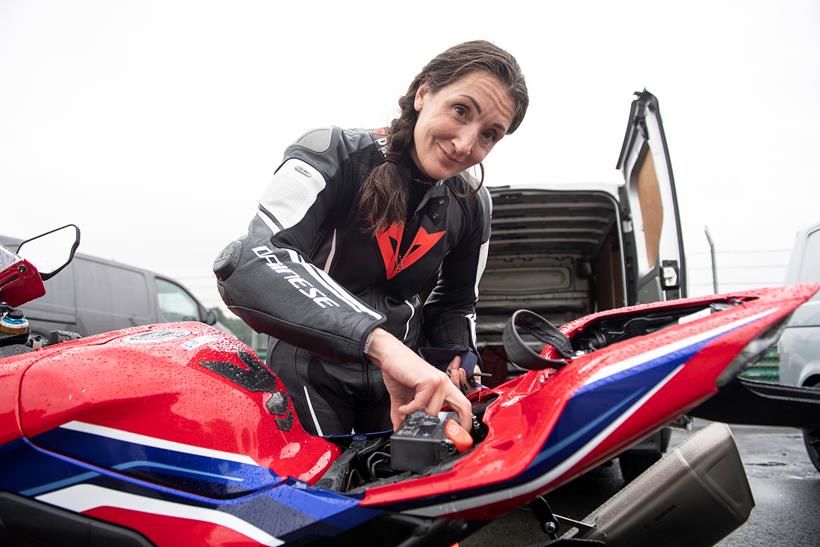
Wired-up, focussed, engaged, thrilled; Honda’s all-new CBR1000RR-R Fireblade SP stirs up lots of emotions, but I never thought flat would be one of them. The sensation started when I noticed that on a couple of occasions the Blade’s battery was discharged when I came to ride it after 48 hours of inactivity.
Instantly, I thought this was down to me leaving the ignition on or something daft like that, draining the tiny lightweight, lithium-ion battery. Connecting it up to a regular charger was enough to boost the juice enough to me to fire the engine into life. The battery charged up happily while I rode and all was fine; the battery’s ions were all positively charged and so were my endorphins, especially as I had a place on the James Whitham School booked – my first opportunity to try the Blade out on track.
Lovingly strapped into the back of my van, I drove two-and-a-half hours through the rain to get to Croft. Once there, I proudly wheeled the Blade down the ramp and into the soggy paddock, then prodded the ignition button. Nothing. I checked the key was in range and switched on. Still nothing. Damn, I must’ve flattened the battery again, somehow… Feeling resourceful, I borrowed a spare bike battery from a fellow trackday rider and connected it to the Blade’s tiny L-ion unit using jump leads I had stashed in the van. Bingo! The ignition lights came on and the micron-perfect components inside the Blade’s all-new 215bhp motor spun into life. Leaving the bike idling, I wriggled myself into leathers and got ready to hit the track… Not so fast…
After 10 minutes ticking over, the Blade cut out and wouldn’t restart. Ah. Maybe I shouldn’t have jump started it? I frantically flicked through the user manual to see if there was any mention of dos and don’ts in relation to the battery, whilst also giving Honda a call to see if they could help.
Turns out, there were a number of factors at play… Firstly, the Blade’s ultra-lightweight Lithium-ion battery had been going flat because of the drain placed upon it by the GPS anti-theft tracker my bike has been fitted with, and therefore needed to be connected to a trickle charger at all times when not in use. I’d assumed that because the bike was used most days, that it would be OK.
Secondly, perhaps because of my jump start or maybe because it had been discharged so many times, my Blade’s battery was now kaput so needed replacing (£322.18). Honda recommend that the CBR1000RR-R should be kept connected to a lithium-ion-specific charger, like the Optimate Lithium 4s 0.8A (£64.99), which I’ve now hard-wired to the Blade’s battery to keep it tip top. Talk about learning the hard – expensive – way!
Update two: Four surprising things about Honda’s CBR1000RR-R Fireblade SP
Published: 30.06.20
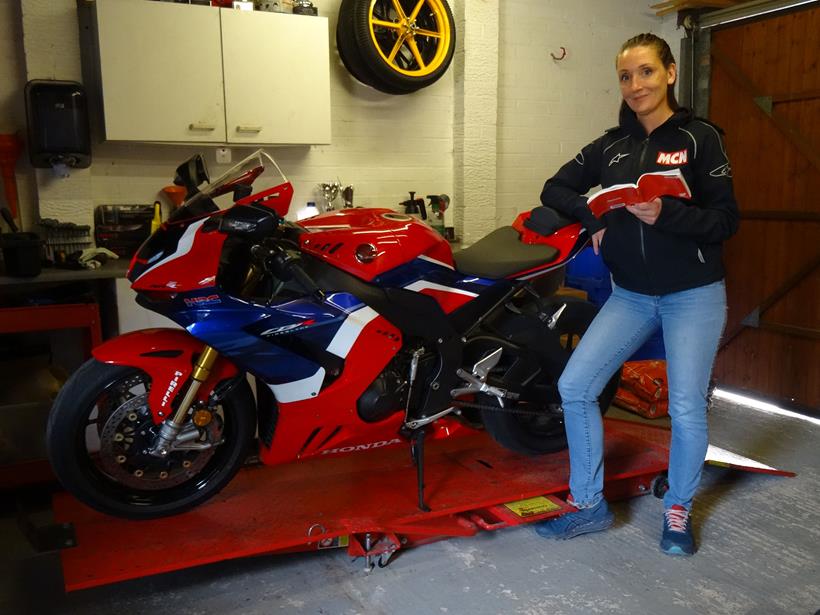
They say good things come to those who wait, and boy have we all had to exercise a bit of patience so far this year.
After three months lockdown, last week I was finally able to collect the Honda CBR1000RR-R Fireblade SP long termer that was due in March, and just the sight of it being wheeled out of Honda’s workshop was enough to ease the frustrations of 12 weeks without a ride.
Heavily influenced by the RC213V-S and built unashamedly for the track, it’s the most radical Blade ever and boasts aerodynamic wings, a highly sophisticated electronics package as well as, Honda claim, the most powerful naturally aspirated inline four production motorcycle engine ever made – an insane 214bhp at a screaming 14,500rpm.
Red, white and blue HRC paintwork looking stunning in the June sunshine, it was time to get my first proper eyeful of this £23,499 ultra-high-tech racer for the road. Here are the first four things that caught my attention before I’d even turned a wheel…
1. ‘How the hell do you start this thing?’
Keyless ignitions are nothing new, but still there’s usually an ‘ignition on’ push button near to where a key barrel would traditionally sit. That’s not the case with the new Blade…
Honda’s Smart Key system has allowed them to do away with a traditional ignition barrel so that the RAM AIR scoop can go straight through the headstock and directly into the airbox, just like the pure prototype RC213V.
Once you have the electronic fob within range, the ignition is then activated via a press-and-hold push button down on the left-hand side of the front subframe, just inside the nose fairing.
To turn the ignition off again, the outer spring-loaded ring of the subframe-mounted button needs to be rocked forward.
As well as allowing maximum airflow into the engine, the coolest thing about the Smart Key ignition system is that it makes the cockpit look like a proper GP racer, because there’s no hint of a traditional production bike ignition barrel. Factory!
2. ‘It’s long…’
You don’t notice it so much in the pictures but up close the Blade’s length is very obvious.
Compared with the previous model, the new RR-R is 50mm longer thanks in part to an all-new swingarm which, despite being 30.5mm longer with more horizontal flex is actually the same weight as the shorter, stiffer 2017 version.
This has been achieved with, yes, you guessed it, more RC213V-inspired production methods; the ‘arm is made from 18 individual-thickness pieces of aluminium that have been pressed together, rather than just a traditional single cast aluminium unit.
3. ‘…but so narrow’
With the largest bores of any 1000cc inline four-cylinder engine (a whopping 81mm, up from the previous model’s 76mm) it’s incredible that Honda have actually made the new Blade’s motor more compact than before.
In fact, it looks odd inside the fairing, as if someone’s replaced the actual engine with a CBR400 lump instead!
This has been achieved through repackaging the starter motor so that it engages with the clutch main shaft rather than the crankshaft, which also allows the use of a shorter idler gear shaft.
The engine is also shorter in length thanks to reduction in distance between the crankshaft, counter shaft and main shafts. This narrow, compact motor has also allowed Honda to maximise the Blade’s agility too.
4. ‘Objective Based Tuning!’ Say what?
The SP Blade comes with Swedish suspension supremoes Öhlins’ Smart EC 2.0 electronic suspension system, which features three pre-set automatic modes, Track, Sport and Rain.
Within these modes, the system alters the damping using feedback from the bike’s IMU, wheel speed sensors and ECU continuously in real time.
The system’s OBTi (Objective Based Tuning interface) is accessible via the Blade’s full-colour dash and, in a nutshell, it allows you to fine tune the damping characteristics in five key areas: Front stiffness, rear stiffness, braking, acceleration and cornering. Each area has 10 levels of adjustability, and each mode can be individually adjusted.
Put simply, it’s a bit like having an Öhlins engineer with you at all times; you decide what you want in terms of an outcome (say, a bit more support on the brakes) and the system makes it easy to achieve.
Well, I say that in theory, I’m still yet to try it out for real yet, but hopefully a trackday or two will allow me to explore more of what the Blade is all about…
Now, where’s that Smart Key…
Update one: introducing the Honda CBR1000RR-R Fireblade SP
Published: 17.03.20
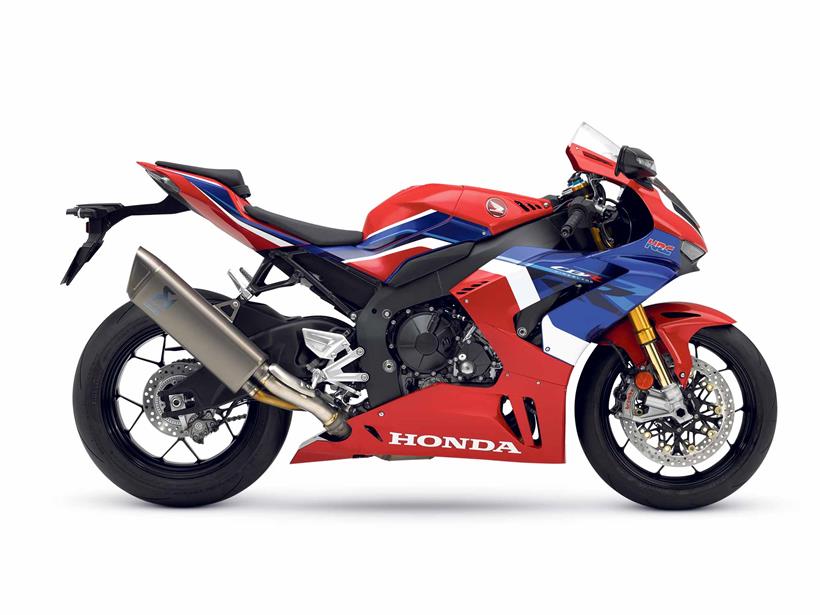
I’ll be using the all-new CBR1000RR-R Fireblade SP precisely how Honda intended – with copious amounts of track action.
I’ll try racy rubber, experiment with its myriad of settings, then get ownership advice from the riders who know it the best – Leon Haslam and Alvaro Bautista.
The rider Emma Franklin, MCN Deputy Editor, 38, 5ft 7in. Riding for 17 years. Rides for fun on road and track. Emma.franklin@motorcyclenews.com
Bike specs 999cc | 215bhp | 201kg | 831mm seat height
More from MCN
- History of the Honda Fireblade range
- Honda CBR1000RR-R SP Fireblade – the story
- Top 10 new and used Honda motorcycles
